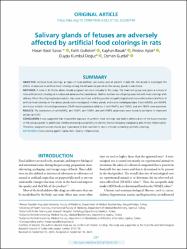Salivary glands of fetuses are adversely affected by artificial food colorings in rats

Göster/
Erişim
info:eu-repo/semantics/openAccessTarih
2021Yazar
Savaş, Hasan BasriGültekin, Fatih
Başak, Kayhan
Aylak, Firdevs
Doğuç, Duygu Kumbul
Gürdal, Osman
Üst veri
Tüm öğe kaydını gösterÖzet
OBJECTIVE: Artificial food colorings, as types of food additives, are widely used at present in daily life. We aimed to investigate the effects of exposure to artificial food colorings during the intrauterine period on the salivary glands in adulthood.
METHODS: A total of 30 Wistar albino female pregnant rats were included in this study. The treatment group was given a mixture of nine artificial food colorings at no observed adverse-effect-level doses. Neither mothers nor offspring were fed with food colorings after delivery. When the offspring became adults, they were sacrificed, and the possible histopathological and immunohistochemical effects of artificial food colorings on the salivary glands were investigated. In these glands, anti-matrix metallopeptidase 2 (anti-MMP2), anti-MMP9, anti-tissue inhibitor of metalloproteinases (TIMP) metallopeptidase inhibitor 1 (anti-TIMP1), anti-TIMP2, and anti-TIMP3 were examined.
RESULTS: The expressions of anti-MMP2, anti-TIMP1, anti-TIMP2, and anti-TIMP3 parameters were found to be higher in treatment groups (p<0.05).
CONCLUSION: It was suggested that intrauterine exposure of synthetic food colorings may lead to deterioration of the tissue structure of the salivary glands in adulthood, thereby increasing susceptibility to chronic illnesses including malignancy and chronic inflammation. Therefore, pregnant women should give importance to their nutrition in terms of foods containing synthetic colorings.
Kaynak
Revista da Associacao Medica BrasileiraCilt
67Sayı
2Bağlantı
https://hdl.handle.net/20.500.12868/1633https://www.scielo.br/j/ramb/a/tgbNj9XKSfhLvgk4bwRSQkj/?lang=en

















